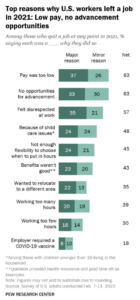Employers have complained loudly about the inability to find and hire qualified talent for many years. The challenge and noise increased further during the pandemic and the ensuing ‘Great Resignation’ that started during the pandemic. The total number of open positions in the US has remained above 10.0 million for more than two years, nearly double the pre-pandemic historical norms of 5.0 to 6.0 million open positions across the US. As of February 2023, according to the US Job Openings and Labor Turnover Summary (JOLTS) Report, open positions dropped slightly to 9.9 million open positions, but according to some economists studying demographic workforce trends, including an aging workforce, the economy is unlikely to return to the prior average level of open jobs in the foreseeable future.
Evidence of the continuing ‘Great Resignation’ and resulting talent war trend continues in 2023 since the same JOLTS Report (February 2023) shows quit rates or turnover increasing slightly to 4.0 million workers or 3.7% of the workforce in February 2023. The 3.7% quit rate, when multiplied by 12 months or annualized, equates to a 44.4% turnover rate, which is 75.5% higher than the decade before the pandemic (Feb 2013 vs. Feb 2023).
The point is that higher levels of employee turnover and increasing competition for jobs make for a challenging environment to attract and retain workers is likely to be the new normal for companies.
Therefore, to win the talent war by attracting, hiring, and retaining good talent, companies must be willing to change how they operate, not just in recruiting but decision-making, accountability, career pathing, and more.
All employees eventually leave a company, whether by retirement (good turnover in many respects), layoffs, or voluntary resignation. What makes a difference is whether the company is improving how it sources, hires, trains, rewards, manages, and retains its best workers.
Companies are, of course, focused on keeping good employee turnover to a minimum. The key is to retain good performers, critical roles, highly engaged employees, and current and emerging stars. The amount of human capital value is lost when a hard-to-fill vital role or high performer leaves, causing work to slow. At the same time, much time is invested in replacing the open position with no guarantee that the replacement will match the level of performance of the prior worker. Since it is much harder today than a decade ago to find great talent in a reasonable amount of time, the company and coworkers struggle while a replacement is found and up to speed. As a result, morale may decrease, and increase the risk of turnover of other good performers may increase, creating a negative growing turnover cycle.
Here are the Seven Mistakes Companies Must Not Make to Win the War for Talent:
- Hiring managers who are unaccountable for their poor hiring decisions.
- Valuing jobs and employees only after they leave a company.
- Recruiting based solely on experience/education/industry.
- Increasing position job requirements to ensure more qualified hires.
- Recruiting/Evaluating/Hiring only for the current job.
- Ignoring the newly hired employee once hired.
- Throwing money at recruiting problems (unless a job is paid well below market).
- Hiring managers who are unaccountable for their hiring decisions. A famous Gallup poll of more than a million employed U.S. workers concluded that the No. 1 reason people quit their jobs is a bad boss or immediate supervisor. In the study, 75% of workers who voluntarily left their jobs did so because of their bosses and not the position itself. “Despite how good a job may be, people will quit if the reporting relationship is unhealthy.”
Marcus Buckingham said it best “People leave managers, not companies…in the end, turnover is mostly a manager issue.” The issue is even worse than what Gallup found. Managers in recruiting wield tremendous power in the hiring process and are typically the final decision-makers as to whether to hire a person for an open job. Suppose the manager needs to make a better hiring decision, even if HR and the rest of the organization do everything right. In that case, the new employee often can leave in the first year (or 90 days in some cases), regardless of whether it was a voluntary or involuntary termination. Worse, who do the manager and the organization typically blame for this failed hire, why, HR, and often, explicitly recruiting? The blame may start with unfounded accusations by the hiring manager or a more senior leader trying to support their junior manager saying, “HR didn’t find us any good candidates,” or “We hired the best we could find from a bad batch.” Therefore, managers conclude that HR needs to do a better job attracting talent. Also, HR can be blamed due to HR pay policies that a position be paid commensurate with internal pay equity and candidate experience level, which translates to “HR doesn’t let us pay enough to get and keep good people.”
The solution to Mistake #1, while simple, requires discipline and management support to execute as described below:
- Management can hold hiring managers accountable for any ‘New Hire Terminations’ within a given amount of time (either 90 days or one year via a New Hire Retention Rate metric). In essence, this holds managers accountable for newly hired employees and whether that employee stays with the organization for a specified amount of time.
- Concurrently, HR should track and score all applicants for open jobs based on an agreed-upon set of criteria for each job. Many applicant tracking systems today enable users to score job applicants on how well they meet selected job requirements. The best systems turn the scoring into a percentile from 0% to 100%. The advantage of this is to share such data with hiring managers to help them make more objective final rounds of interviewing and hiring decisions.
- Lastly, another metric is to track and digitize each hire based on who agreed or voted (i.e., hiring manager, HR, recruiter, Higher manager director) to make an offer to a candidate. Over time, managers who are terrible talent scouts are easily identified. In one financial services company case study, when both the recruiter and the hiring manager agreed upon the hire, the retention rate of the new hire was 2x the retention rate when only the hiring manager approved the hire against HR’s advice.
- Valuing jobs and employees only after they leave the organization. While this seems obvious, it is one of the great truisms of managers frequently beset with a need to replace departing good employees who are relied on as essential contributors. Unfortunately, these essential contributors are also easily ignored and overloaded with work. The famous saying “the squeaky wheel gets the grease” applies to employees, with some of the best employees are rewarded with more work while others consume more time and resources. This issue manifests as a high-performing employee voluntarily departing and the direct manager suddenly realizing the employee was doing the work in two or even three positions. As a former head of compensation for a publicly traded bank and large privately held real estate firm, I often saw this scenario. Hiring managers would submit a requisition to hire a replacement for a departing employee. Yet, it would have two or sometimes three separate requisitions for a single vacancy, doubling or tripling the cost.
If the manager were to realize the organization’s risk in advance, they could have proactively invested in positive feedback, better salary increases, rewards and recognition, and training for co-workers and appointing future successors to enable automatic backfilling of some or all skills. In effect, if managers genuinely value each employee as if they may leave or be promoted at any time, they will treat the employee better, recognize and reward better, and most importantly, have defined career paths and successors, pushing continual cross-training and career development.
- Recruiting based solely on experience/education/industry. Managers, overly reliant on experience, education, and industry-relevant knowledge/expertise, often need to pay more attention to the three most robust predictors of future job success and retention.
The solution is to focus on what potential employees want, a career, a community, and a cause (see Harvard Business Review Feb 2018, The 3 Things Employees Really Want: Career, Community, Cause (hbr.org)” 1).
- Career includes a defined career path and growth potential, meaning the ability for the employee to grow with the organization over time, assuming good job performance. This also includes cultural and motivational fit meaning a job is intrinsically motivating and that employee gets satisfaction.
- Community includes feeling respected, cared about, being part of a team, recognized by others, and today increasingly has job flexibility and autonomy in skilled roles.
- Cause reflects a sense of purpose, that the employee is making a meaningful impact, aligned with an organizational mission, and doing good in addition to doing well. This element is often reflected in employee engagement surveys which ask employees to rate the questions “I am proud to come work for XXX Co.” and “I am proud to go to work each day.”
- Increasing the job requirements for a position to ensure a more qualified hire is closely related to #3 above. Hiring managers who feel pressured to fill a role and restart work quickly may interpret that if no time is used to train a new hire, they can get an immediate boost by increasing the job requirements. Examples of growing job requirements include advancing years of experience, increasing the required education level, adding certificates/certifications, and requiring more industry expertise. Managers following this path to success unknowingly will likely doom the new super job to dramatically fewer job candidates, longer time to fill the job, significantly increased cost, and a plateaued employee with little or no career growth. Such a position becomes a job with less chance of meeting what employees want (see #3 solution above) and may spend more time as an open position unless hiring managers actively practice answers to #1, #2, and #3 Above.
- Recruiting/Evaluating/Hiring only for the current job. As described, this is short-term thinking at its worst and, combined with #4, may make a position harder to fill and one without a defined career path since the employee is expected to have plenty of experience. Additionally, such positions in less technical roles are subject to competitor talent cherry-picking via higher pay leaving no successor due.
- Ignoring the newly hired employee once hired. Once hired, even one experienced and qualified employee still requires considerable time to fully develop in a new organization due to unique aspects of work, decision-making, support systems, tools, and technologies. The largest of the learning curve challenges often is navigating the human capital aspects of employment, whom to go to for specific questions, how to work with others in the team, how decisions are made, and what it takes to fit into organization culture. Hired and ignored employees can fail regardless of expertise, experience, and competence if rejected by the company culture, co-workers, departments, and leaders. In such situations, it is far easier for the employee, sensing that they have no support from their boss, to leave and go on to the next company.
- Throwing money at recruiting problems can be like putting out a fire with paper. The problem, like fire, gets bigger. In the field of compensation, trying to adjust compensation significantly for one individual or position can have the inadvertent effect of creating many unhappy employees and positions all around it since, in most cases, employees end up discovering what other employees make in salary or total compensation. In addition, once a pay disparity is created as an exception for a position, it can create internal havoc across more extensive sections of the workforce.
The solution to #7 is to hire the best available talent that is a good fit with the internal wage structure and the external market, rather than a weak manager simply trying to get an exception to salary and wage policies to make their department more stable and secure. Unfortunately, this is another form of sub-optimization that many large companies experience as hiring managers seek to optimize their situation without regard to the impact on larger organizations.
Note: research for this article includes a February 2022 Pew Research Center study examining why employees left their jobs in 2021. See chart.

Endnotes

